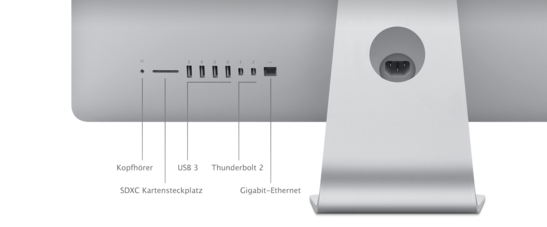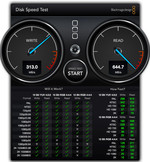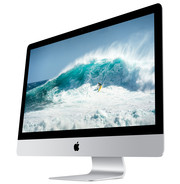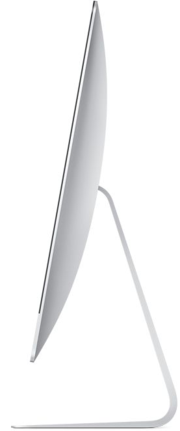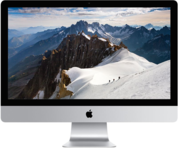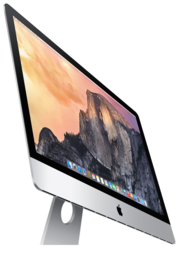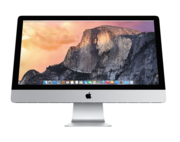Apple iMac Retina 5K 27" Review
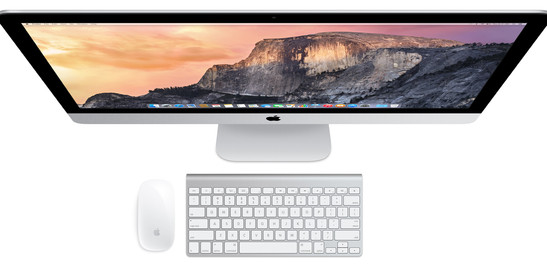
For the original German review, see here.
Following the success of the MacBook Retina series, Apple is now releasing an iMac with a Retina 5K display. Like the displays in the MacBook Retina series, the display has an exceptionally high ppi value; a feature with which the manufacturer hopes to entice potential buyers. With a resolution of 5120x 2880 pixels, the display's ppi is 217, just below the 13-inch MacBook Pro 13's 227 ppi. However, we are particularly interested in the machine's inner workings. The iMac's slim build calls for a mix of mobile laptop hardware and powerful desktop components. In the configuration of our test device, an Intel Core i7-4790k is responsible for performance. The computer's AMD Radeon R9 M295X is particularly interesting. Apple was the first to implement this AMD graphics card, which performance-wise lies just below the Nvidia GeForce GTX 970M. At the beginning of the year, Alienware announced that they too would integrate this card in their brands. The starting price for the Apple iMac Retina is 2600 Euros (~$2950). In our case, we tested a version with a substantially more powerful performance, priced at 3300 Euros (~$3750). Input devices are included with every version. In terms of the keyboard, the buyer has a choice between a wired keyboard with a number pad and a wireless keyboard. Instead of a Magic Mouse, the customer has the option of selecting a Magic TrackPad.
Configuration options:
| CPU | RAM | HDD/SSD | GPU | |
|---|---|---|---|---|
| Basis | Intel Core i5-4690 | 8 GB 1600 MHz DDR3 SDRAM | 1 TB Fusion Drive | AMD Radeon M290X 2GB DDR5 |
| Upgrade | Intel Core i7-4790K (+ 250 Euros) | 16 GB 1600 MHz DDR3 SDRAM (+200 Euros) | 3 TB Fusion Drive (150 Euros) | AMD Radeon M295X 4GB DDR5 (+ 250 Euros) |
| 32 GB 1600 MHz DDR3 SDRAM (+600 Euros) | 256 GB flash storage | |||
| 512 GB flash storage (+300 Euros) | ||||
| 1TB flash storage (+800 Euros) | ||||
| Our test device | Intel Core i7-4790K | 16 GB 1600 MHz DDR3 SDRAM | 1 TB Fusion Drive | AMD Radeon M295X 4GB DDR5 |
Case & Connectivity
Apple has always stood out from the crowd with its modest, elegant look. The 5K version does not stray from this beaten track. The display is housed in an aluminum case. The iMac's back is especially eye-catching. Instead of edges and corners, Apple has opted for a smooth, curved look. The stand has not changed since the G5 generation, and allows the user to adjust the screen vertically. As always, quick access to connections is hindered by their inconvenient position on the back of the device. When it comes to maintenance and upgrades, laymen should limit themselves to the simple task of expanding the working memory. As our colleagues at iFixit show, the entire display has to be removed for replacements and repairs.
Performance
It is not just the Retina display that makes the iMac attractive: The performance is also a showstopper. A desktop CPU combined with a high-end mobile graphics card gives the machine enough power to run numerous multimedia applications, and even to render new games smoothly at high quality settings. However, the graphics card quickly reaches its limits running current games. Often users will be unable to savor their favorite games at full resolution.
Processor
The Apple iMac 5K with Retina Display is equipped with an Intel Core i7-4790k CPU. This processor clocks at 4.0 GHz, and using turbo it can reach a frequency of up to 4.4 GHz. We have already seen this desktop processor once before, in the One K73-5N notebook. The Cinebench R15 benchmark should tell us whether the CPU is able to use its full processing potential. In the multi-core test, the iMac scores around 806 points under both Mac OS and Windows 8.1. The One K73-5N and an Asus desktop PC (equipped with the same CPU) were able to score 40-50 points higher. The iMac lags behind by about 10 points in the single-core test too. A look at the clock rates reveals that the CPU runs almost exclusively at its base clock rate and only uses part of its turbo at the start. The Cinebench R15 benchmark's OpenGL test shows a significant contrast between the two operating systems. Under Mac OS, the system reaches only 60 fps, versus 131 fps under Windows, more than double.
| Cinebench R15 - CPU Multi 64Bit (sort by value) | |
| Apple iMac Retina 5K 27 Late 2014 i7-4790K M295X | |
| One K73-5N | |
| Sapphire Radeon R9 290X Tri-X OC | |
System Performance
Working on the iMac is just plain fun - as long as it is under Mac OS. The reaction times and processing speed of our test device are great under the Mac operating system. Using Bootcamp, we installed Windows 8.1, which proved to be perceptibly slower. Subjectively at least, under Windows the user is delayed by delays and waiting times, although this could be due to the Fusion Drive. The PCMark 8 results are good, although the iMac comes in behind the Schenker XMG U505 and the One K73-5N. The reason: The latter two are equipped with SSDs and more powerful graphics units.
| PCMark 8 | |
| Home Score Accelerated v2 (sort by value) | |
| Apple iMac Retina 5K 27 Late 2014 i7-4790K M295X | |
| One K73-5N | |
| SCHENKER XMG U505 | |
| Lenovo Y70 DU004HUS | |
| Creative Score Accelerated v2 (sort by value) | |
| One K73-5N | |
| SCHENKER XMG U505 | |
| Lenovo Y70 DU004HUS | |
| Work Score Accelerated v2 (sort by value) | |
| Apple iMac Retina 5K 27 Late 2014 i7-4790K M295X | |
| One K73-5N | |
| SCHENKER XMG U505 | |
| Lenovo Y70 DU004HUS | |
| PCMark 8 Home Score Accelerated v2 | 4746 points | |
| PCMark 8 Work Score Accelerated v2 | 4918 points | |
Help | ||
Storage Devices
In terms of mass storage, Apple has called their combination of an HDD and an SSD a “Fusion Drive”. Our test device is equipped with a 1 TB Fusion Drive. Apple allows up to 3 TB in their configuration. For more speed, it is possible to select just a solid-state drive at additional cost. Under Windows 8.1, CrystalDiskMark shows average speeds for a magnetic hard disk. This information tells us that the system only employs the HDD here. Under Mac OS, we used the program Blackmagic Disk Speed Test to analyze the computer's read and write speeds. Here we reached read speeds of up to 644 MB/s and write speeds of 313 MB/s. These numbers correlate with the speed of a 128 GB flash drive, revealing that this faster drive is used primarily under Mac OS. The most frequently used programs are automatically stored on the flash drive, and the rest of the computer's data is relegated to the slower HDD. Apple does not support this system under Windows.
Graphics Card
Apple has selected an AMD Radeon M295X for our test device. Alienware has announced that they will follow suit. The built-in graphics unit has a core clock frequency of 850 MHz and a memory clock speed of 1362 MHz. Performance-wise, this is a high-end card. A close look at the GPU's scores in 3DMark 11 and 13 reveal where the new AMD Radeon M295X positioned on the performance ladder. Although the AMD card can still keep up with the Nvidia GeForce GTX 970M in 3DMark 11, the story changes in 3DMark 13. The Schenker XMG U505, equipped with an Nvidia GeForce GTX 970, scores 9% higher than the iMac. However, the Radeon M295X remains about 10% more powerful than the Nvidia GTX 880M.
| 3DMark 11 - 1280x720 Performance (sort by value) | |
| Apple iMac Retina 5K 27 Late 2014 i7-4790K M295X | |
| SCHENKER XMG U505 | |
| Asus G750JZ-T4023H | |
| Acer Aspire V 17 Nitro (VN7-791G-759Q) | |
| 3DMark - 1920x1080 Fire Strike Score (sort by value) | |
| Apple iMac Retina 5K 27 Late 2014 i7-4790K M295X | |
| SCHENKER XMG U505 | |
| Asus G750JZ-T4023H | |
| Acer Aspire V 17 Nitro (VN7-791G-759Q) | |
| 3DMark 06 Standard Score | 35421 points | |
| 3DMark Vantage P Result | 29972 points | |
| 3DMark 11 Performance | 9516 points | |
| 3DMark Ice Storm Standard Score | 146593 points | |
| 3DMark Cloud Gate Standard Score | 22311 points | |
| 3DMark Fire Strike Score | 6123 points | |
Help | ||
Gaming Performance
To verify the results of 3DMark benchmark, we test systems under the specific conditions of the gaming world. Crysis 3 is a perfect candidate for this test. Even at maximum graphics settings (FHD), the computer is able to reach smooth frame rates. The iMac Retina 5K's 33.9 fps is on par with the Schenker XMG U505's result. The Schenker machine is equipped with an Nvidia GeForce GTX 970M. It is only when running the WatchDogs that the difference between the two cards is obvious. The MSI GS60, also equipped with an Nvidia GeForce GTX 970M, manages to render about 15% more frames per second. In order to reach the computer's maximum frames per second, we installed a Windows partition via Bootcamp. As we have seen in previous reviews, most ported games manage considerably fewer fps under Mac OS than under Windows.
| Watch Dogs - 1920x1080 Ultra Overall Quality, Ultra Textures AA:4x MS (sort by value) | |
| Apple iMac Retina 5K 27 Late 2014 i7-4790K M295X | |
| MSI GS60 2QE Ghost Pro 4K (2QEUi716SR51G) | |
| Crysis 3 - 1920x1080 Very High Preset AA:2xSM AF:16x (sort by value) | |
| Apple iMac Retina 5K 27 Late 2014 i7-4790K M295X | |
| SCHENKER XMG U505 | |
| low | med. | high | ultra | |
| Crysis 3 (2013) | 134 | 33.9 | ||
| Need for Speed: Rivals (2013) | 30 | 30 | ||
| Watch Dogs (2014) | 41.5 | 31.2 | ||
| Alien: Isolation (2014) | 161.4 | 81.2 | 67 | |
| Dragon Age: Inquisition (2014) | 142 | 51 | 35.2 |
Emissions
Temperature
In 2012, Apple said goodbye to cuboid cases and rounded off the back of their iMacs. We use a stress test to determine how well the machine cools itself. For this purpose, we run the programs FurMark and Prime95 to simulate extreme load. As soon as we started the test on the iMac, the CPU clock rate fell to 3 GHz and occasionally climbed to higher frequencies of up to 3.4 GHz. The sensors recorded CPU temperatures of almost 100 °C (212 °F). After an hour in the stress test, the CPU's clock frequency leveled off at a little over 3 GHz. After our stress test was complete, we immediately started 3DMark 11 to determine whether the device could utilize its full performance power directly following an experience of heavy load. With a score of 9420, the machine is definitely able to do this. Another problem with the old iMac was the case's tendency to heat up tremendously. Subjectively however, even after two hours in the stress test, our test device's case did not grow exceptionally warm.
Speakers
The iMac's speakers make a good impression. A broad spectrum of tones and good volume will please music and film lovers alike. However, for rich, full bass tones, the user will need to plug in external speakers or headphones. Overall, the test device does a good job.
Verdict
Let us set aside the question of whether the 5K display is an advantage for the average users. However, when it comes to video editing we quickly noticed a difference between this machine and the non-Retina version. Editing 4K films in particular, can benefit from the possibility of using the native resolution alongside toolbars and other menu bars. Our configuration of the iMac Retina currently costs 3300 Euros (~$3750; starting price 2600 Euros or about $2950). In this price range, we expect everything about the device to be high quality. In terms of the computer's case and manufacturing quality, the iMac definitely meets our standards. Unfortunately, it lacks upgradability and maintenance options. The hardware proves to be a good combination of mobile and stationary performance. Even so, the performance power is limited by the mobile graphics, and the CPU quickly dropped below its base clock frequency in our stress test. No one solely concerned with the computer's price/performance ratio would be pleased with the iMac Retina. But those who love excellent image quality and a good design - and have a certain degree of affinity for Apple - will find this computer, like so many of Apple's creations, to be an alluring product.


 Deutsch
Deutsch English
English Español
Español Français
Français Italiano
Italiano Nederlands
Nederlands Polski
Polski Português
Português Русский
Русский Türkçe
Türkçe Svenska
Svenska Chinese
Chinese Magyar
Magyar